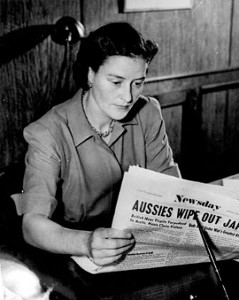Alicia Patterson facts for kids
Quick facts for kids
Alicia Patterson
|
|
|---|---|
 |
|
| Born | October 15, 1906 |
| Died | July 2, 1963 (aged 56) |
| Occupation | Journalist |
| Spouse(s) |
James Simpson, Jr.
(m. 1929; div. 1930)Joseph W. Brooks
(m. 1931; div. 1939) |
| Parent(s) |
|
Alicia Patterson (October 15, 1906 – July 2, 1963) was an American journalist. She was the founder and editor of Newsday, a well-known newspaper. She also helped create the Deathless Deer comic strip in 1943 with Neysa McMein.
Contents
Alicia Patterson's Early Life
Alicia Patterson was born on October 15, 1906. Her father, Joseph Medill Patterson, started the New York Daily News newspaper. Her great-grandfather, Joseph Medill, owned the Chicago Tribune. This shows that journalism was in her family!
When Alicia was four, her father sent her to Germany to learn German. As she grew up, her father taught her daring sports like high diving and jumping while riding horses. He wanted to test her courage.
Alicia went to several schools, including the Francis Parker School in Chicago. She also attended finishing schools in Maryland and Switzerland. She was known for being a bit rebellious and was even asked to leave some schools for breaking rules.
Alicia Patterson's Marriages
Alicia Patterson was married three times. Her first marriage was to James Simpson, Jr. in 1929. They were married for about a year. During this time, she learned to fly a plane with her father. She also went on a hunting trip in Indochina.
In 1931, she married Joseph W. Brooks. This marriage ended in 1939.
Later in 1939, she married her third husband, Harry Frank Guggenheim. He had been an ambassador for the United States in Cuba. During World War II, Harry was serving in the military. Alicia took charge of running Newsday during this time. When Harry returned, he helped with the business side of the newspaper.
Alicia Patterson's Journalism Career
Alicia Patterson started working at her father's newspaper, the Daily News, in 1927. She began in the promotion department and later became a reporter. She enjoyed spending time with other young reporters.
Creating Deathless Deer
Alicia also had a career in comics. She helped create a comic strip character called Deathless Deer with Neysa McMein. This comic appeared in newspapers like the Boston Herald and the Chicago Tribune in 1943.
Founding Newsday
In 1940, Alicia's husband, Harry Guggenheim, used some of his family's money to help her buy a newspaper in Hempstead. This is how Newsday was founded. Harry gave Alicia 49% of the newspaper's ownership.
Newsday quickly became a respected newspaper. It was known for its "lively style" and for doing investigative journalism, which means reporters dig deep to find important facts. The newspaper also covered politics in a fair way.
In 1954, Newsday won the Pulitzer Prize, a very important award for journalism. It grew to become the largest suburban newspaper in the country. Alicia used the newspaper to help create a strong identity for Long Island.
Alicia Patterson made sure Newsday was fair in its news coverage. She gave equal attention to both Republican and Democratic candidates. Under her leadership, Newsday grew to be one of the largest newspapers in the country. It had almost 400,000 readers by the 1960s. Alicia was a determined and smart editor. She believed in making "a good newspaper" above all else.
Alicia Patterson's Death
Alicia Patterson passed away on July 2, 1963, at the age of 56. She had complications after stomach surgery. Her ashes were buried at her hunting lodge in Kingsland, Georgia.
After her death, her friend, author John Steinbeck, wrote a series of articles for Newsday. These articles were called "Letters to Alicia." In them, he shared his thoughts on different topics. Harry Guggenheim took over as editor of Newsday after Alicia's death.
Alicia Patterson's Legacy
Alicia Patterson was honored with a mural called Alicia by artist Joan Miró. This mural is at the Guggenheim Museum.
The Alicia Patterson Foundation was created based on her wishes. This foundation gives an annual prize to journalists who are in the middle of their careers. This helps support good journalism, just as Alicia believed in.

